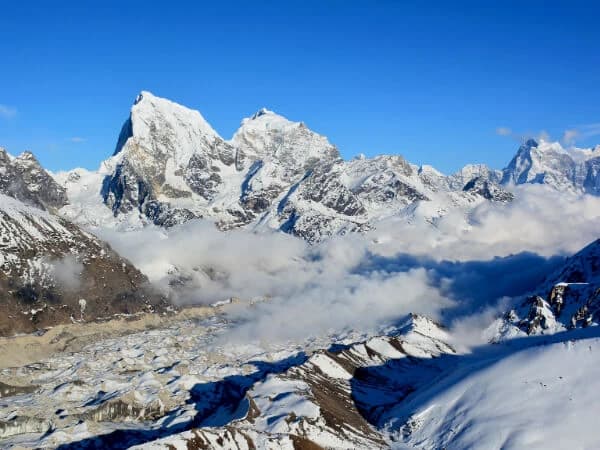Trekking Routes in the Makalu Region
- Difficulty: Moderate
- Duration: 19 days
- Highlights: Rich biodiversity, stunning views of Everest and Makalu, cultural encounters with Rai and Sherpa communities.
- Difficulty: Challenging
- Duration: 22 days
- Highlights: Panoramic views of Makalu, Everest, Lhotse, and Kanchenjunga; remote and untouched trails; cultural immersion in Sherpa villages.
When is the Best Time to Trek in the Makalu Region?
Ideal Trekking Seasons
The best time to trek in the Makalu region is during Spring (March-May) and Autumn (September-November). During these periods, the weather is generally stable, with clear skies and moderate temperatures. Spring brings blooming rhododendrons, while autumn offers crisp air and excellent visibility for mountain views.
Off-Season Trekking
Winter (December-February) and Monsoon (June-August) trekking are possible but come with challenges. Winter treks can be extremely cold, with heavy snowfall blocking some routes, while monsoon season brings heavy rain, leeches, and slippery trails. However, trekking during these times offers solitude and the chance to experience the region without the crowds.
How to Get to the Makalu Region?
Transport Options
Getting to the Makalu region typically involves a flight from Kathmandu to Tumlingtar, a small airstrip that serves as the gateway to the region. From Tumlingtar, trekkers usually take a jeep or bus to Num, the starting point of most treks in the area.
Essential Travel Tips
- Permits: Trekkers need a Makalu-Barun National Park permit and a TIMS card (Trekkers' Information Management System) to enter the region.
- Packing: Prepare for a range of conditions. Essential items include a sturdy pair of trekking boots, a warm sleeping bag, and layers of clothing for fluctuating temperatures.
What to Expect on the Makalu Region Trek?
Day-by-Day Itinerary Highlights
The Makalu trek is an adventure through remote areas, with stages including:
- Tumlingtar to Seduwa: Initial low-altitude trekking through lush forests and terraced fields.
- Seduwa to Tashigaon: The last permanent settlement before heading into higher altitudes.
- Tashigaon to Khongma Danda: Steep ascent into alpine territory with stunning views.
- Shipton La Pass: A challenging pass offering panoramic views of Makalu and other Himalayan giants.
- Makalu Base Camp: The climax of the trek, with breathtaking views of Mount Makalu and the surrounding peaks.
Major Highlights of the Trek
- Panoramic Mountain Views: Spectacular vistas of Mount Everest, Makalu, Lhotse, and Kanchenjunga.
- Wildlife Encounters: Possible sightings of Red Panda, Snow Leopard, and other Himalayan wildlife.
- Cultural Immersion: Interaction with Sherpa and Rai communities, experiencing their unique traditions and hospitality.
Challenges and Rewards of Trekking in the Makalu Region
Physical and Mental Preparation
Trekking in the Makalu region requires a good level of fitness and mental resilience. The trails are steep and rugged, often requiring long days of hiking at high altitudes. Altitude sickness is a significant risk, making acclimatization days essential.
Rewards of the Trek
The rewards of trekking in the Makalu region are immense. Reaching Makalu Base Camp is a moment of pure achievement, offering views that few others have seen. The trek also provides a deep sense of connection with nature and local cultures, making it a truly transformative experience.
Accommodation and Dining on the Makalu Region Trek
Where to Stay
Accommodation in the Makalu region primarily consists of tea houses and lodges. These are basic but comfortable, offering a bed and meals. In more remote areas, facilities may be limited, so be prepared for more rustic conditions.
What to Eat
The local cuisine is simple but hearty, perfect for the demanding conditions of trekking. Expect to eat a lot of dal bhat (lentil soup with rice), noodles, and potatoes. Tea houses typically offer a small menu, with vegetarian options being the norm.
Preparation for the Makalu Region Trek
Necessary Permits and Documentation
Before you set out, ensure you have the required permits:
- Makalu-Barun National Park Permit
- TIMS Card (Trekkers' Information Management System)
These permits are essential for entering the region and should be obtained in Kathmandu before departure.
Packing Essentials
Your packing list should be comprehensive:
- Trekking Boots: Sturdy and broken-in.
- Cold-Weather Gear: Down jacket, thermal layers, gloves, and a warm hat.
- Camping Equipment: If not relying on tea houses, bring a tent, sleeping bag, and cooking gear.
- Personal Items: First aid kit, water purification tablets, and a reliable headlamp.
Safety and Environmental Considerations
Trekking Safety Tips
- Hiring Guides and Porters: Local guides and porters are invaluable. They know the terrain, help carry heavy loads, and can be lifesavers in emergencies.
- Emergency Procedures: Always have a plan for emergencies, including evacuation routes and emergency contact numbers. Ensure your insurance covers high-altitude trekking.
Environmental Impact
Trekking in the Makalu region requires a commitment to responsible practices:
- Leave No Trace: Pack out all trash, minimize your footprint, and respect local customs and wildlife.
- Conservation Efforts: Support conservation initiatives in the Makalu-Barun National Park by following park rules and contributing to local projects.




